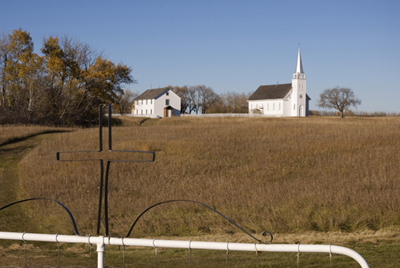Batoche National Historic Site of Canada
Batoche, Saskatchewan

General view
© Parks Canada Agency / Agence Parcs Canada, David Venne, 2007.
Address :
Highway 225, Batoche, Saskatchewan
Recognition Statute:
Historic Sites and Monuments Act (R.S.C., 1985, c. H-4)
Designation Date:
1923-05-25
Dates:
-
1870 to 1930
(Construction)
-
1885 to 1885
(Significant)
Event, Person, Organization:
-
Battle of Batoche
(Event)
-
North-West Rebellion / Métis Resistance
(Event)
-
Louis Riel
(Person)
-
Gabriel Dumont
(Person)
-
Major-General Middleton
(Person)
-
Métis
(Organization)
-
One Arrow First Nation
(Organization)
-
North West Field Force
(Organization)
Other Name(s):
-
Batoche
(Designation Name)
Research Report Number:
1999-012A; 1998-057; 1999-012; 1962-072
DFRP Number:
14442 00 / 22685
Plaque(s)
Existing plaque: Batoche National Historic Site of Canada, Batoche, Saskatchewan
In 1872 Xavier Letendre dit Batoche founded a village at this site where Métis freighters crossed the South Saskatchewan River. About 50 families had claimed the river lots in the area by 1884. Widespread anxiety regarding land claims and a changing economy provoked a resistance against the Canadian Government. Here, 300 Métis and Indians led by Louis Riel and Gabriel Dumont fought a force of 800 men commanded by Major-General Middleton between May 9 and 12, 1885. The resistance failed but the battle did not mean the end of the community of Batoche.
*Note: This designation has been identified for review. A review can be triggered for one of the following reasons - outdated language or terminology, absence of a significant layer of history, factual errors, controversial beliefs and behaviour, or significant new knowledge.
Description of Historic Place
Batoche National Historic Site of Canada is located near the South Saskatchewan River north of Saskatoon, Saskatchewan. The site, which encompasses the vestiges of the Métis village of Batoche where the Carlton Trail crossed the river, is dominated by a church and rectory of the parish of St.-Antoine-de-Padoue, established by the oblates of Mary Immaculate in the late-19th century. Batoche was also the site of the 1885 battle between forces of the Métis provisional government and those of the Canadian government. The designation refers to the remnants of the village, the battlefield, Carlton Trail, and surviving elements of the surrounding community including its distinctive river lot layout.
Heritage Value
Batoche was designated a national historic site of Canada in 1923 to commemorate: the site of the armed conflict between the Métis provisional government and the Canadian government in 1885; the Métis community of Batoche; the Métis river lot land use patterns.
The heritage value of Batoche National Historic Site of Canada lies in its historical associations with the 1885 armed conflict, the Métis community from 1879 to the present, and the river lot land use pattern as illustrated by the relict landscape and cultural resources surviving as witness to those themes. The original village site was abandoned by 1920 but continued to be the centre of Métis cultural activities. After that time, community life revolved around the parish buildings and commercial establishments near the Caron House. River lot farming persisted but the Métis population decreased as many left the area.
Sources: Historic Sites and Monuments Board of Canada, Minutes, 1970, 1972, 1989; Commemorative Integrity Statement, March 1997.
Character-Defining Elements
Key elements that contribute to the heritage character of the site include: the distinct zones relating to the village, the river lots, the battlefield, and the Carlton Trail; the location of the community near the point where the Carlton Trail crosses the South Saskatchewan River; the evidence of the organization of land according to the Métis river lot system; the archaeological remnants associated with Métis life; the vestiges of the former telegraph cut line; the evidence of the former Carlton Trail and Humboldt River trail; the surviving survey mounds marking the Dominion Lands survey of the townsite; the surviving historical vegetation patterns; the evidence of settlement patterns at ferry crossing and around the church and rectory; the archaeological evidence of pre-1885 buildings and their spatial inter-relationships; the surviving buildings associated with the Métis Resistance and the original community in their locations, footprints, massing, surviving original interior layouts, use of local construction materials and traditional Métis construction techniques, in particular the Red River frame of the church and rectory, and the dovetailed log construction of the Caron House; the evidence of armed conflict, particularly in the area southeast of the village, including vestiges of landscape modifications associated with the Battle of Batoche, such as rifle pits and zareba in their footprints, forms and materials; all archaeological resources associated with the battle; the natural features integral to the understanding of the battle including Mission Ridge, the raised ground of the zareba site, treed copses and ravines; Gunner Phillips’ grave site; the vestiges of the historic trail leading from the battlefield to the river crossing, and that from the village through open fields and poplar bluffs to the battlefield; the viewplanes and sight lines relevant to the battle such as those from the zareba to the coulee bluffs beyond the Caron House, those from the Jolie Prairie to the area of the church, rectory and cemetery, those from the Jolie Prairie to the area occupied by the Field Force near Mission Ridge, views of the river and west side from the rifle pits, Mission Ridge and the area above East Village, views of the Carlton trail from above the East Village, views of the East Village from the area of the Church; the viewscapes from the East Village to lot patterns along the river and to other resources associated with the community such as the cemetery, ferry house, and the West Village.
Collection:
Professional and Technical Service Centre
Parks Canada Agency
Western Canada Service Centre
1st floor, 145 McDermot Avenue
Winnipeg, Manitoba
R3B 0R9
(Location of off-site objects from the Batoche National Historic Site of Canada, which include archaeological resources associated with the battle of 1885 and archeological remains related with the Métis life.)